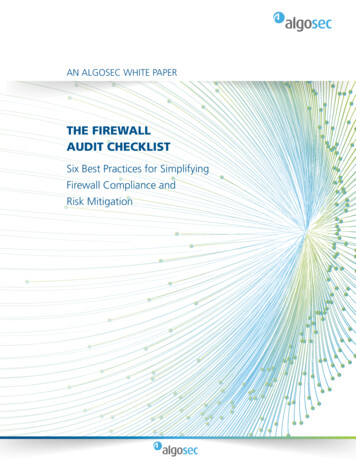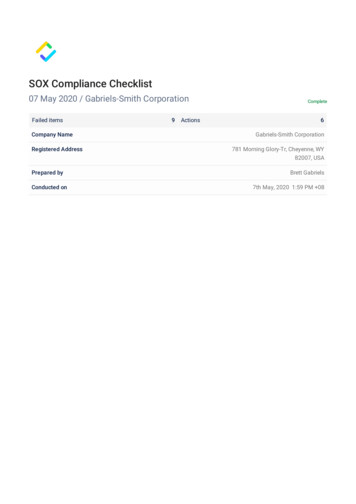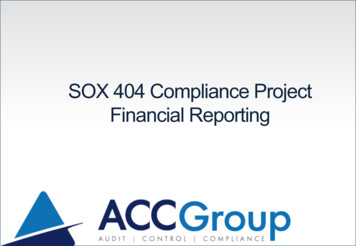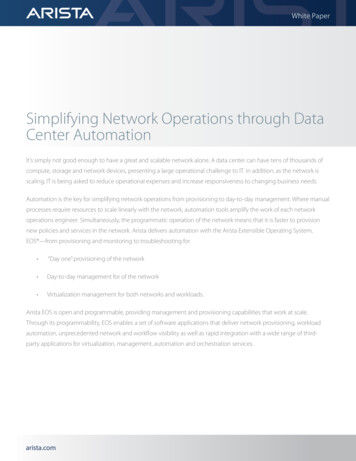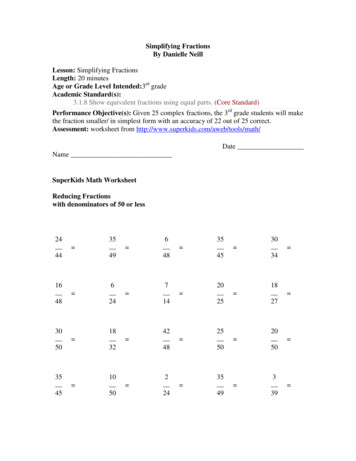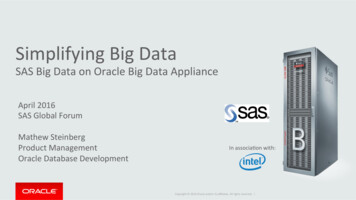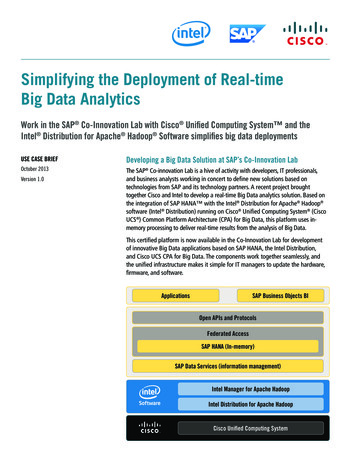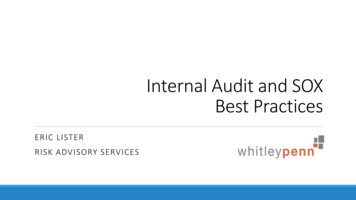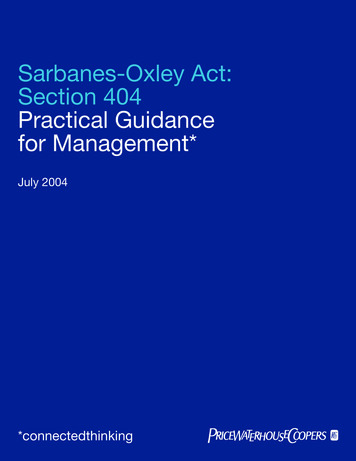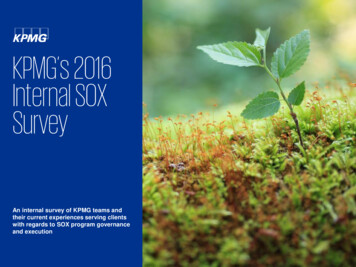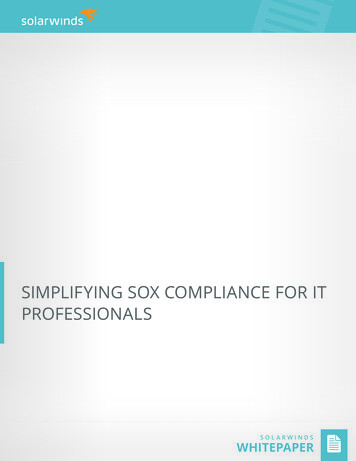
Transcription
SIMPLIFYING SOX COMPLIANCE FOR ITPROFESSIONALS
SIMPLIFYING SOX COMPLIANCE FOR ITPROFESSIONALSYou’ve probably heard people discussing the Sarbanes-Oxley (SOX) Act, or have read somethingabout it online, but you may still be wondering how it impacts your work as an IT professional.It’s pretty straightforward: If you work for a U.S.-based, publicly traded organization, a U.S.based privately held company poised for IPO, or a subsidiary of a foreign company that isbased in the U.S., and you are responsible for the IT used to maintain that company’s electronicfinancial records, you are required to comply with SOX.The Sarbanes-Oxley Act was enacted by Congress in reaction to a number of corporateaccounting scandals uncovered in the early 2000s. Its purpose is to force organizations toadopt a level of financial transparency that would prevent future fraudulent activities. Thework of maintaining SOX compliance touches every aspect of IT operations involved in thefinancial and accounting functions within an organization.Your company must configure the entire IT infrastructure, from IT processes and operationsto network and server security to be able to maintain and then demonstrate SOX compliance.Almost every aspect of your IT operations are affected by SOX compliance, which can includeany communications relating to finance or accounting that your company transmits via newcommunication platforms, such as social media, blogs, intranets, or wikis.This paper offers an overview of the Sarbanes-Oxley Act, the concerns it poses for IT professionals,guidelines for data archiving and storage to meet SOX retention regulations, and the codes ofethics, processes, financial reporting, and procedures of which you need to be aware.While SOX compliance regulations apply mainly to publicly listed institutions, Section 802of the Sarbanes-Oxley Act states that anyone who knowingly “ alters, destroys, mutilates,conceals, covers up, falsifies, or makes a false entry in any record, document, or tangibleobject with the intent to impede, obstruct, or influence ” a federal investigation can be finedand subject to up to 20 years imprisonment. So, clearly, the stakes are high.Finally, while you may not currently work for a company that must maintain SOX compliance,if you do business with a public company, you may be required to prove compliance. There arebenefits to educating yourself on the Sarbanes-Oxley Act’s requirements and working towardcompliance, primary among them is improved security for your firm.page 1
WHITEPAPER: SIMPLIFYING SOX COMPLIANCE FOR IT PROFESSIONALSA BRIEF OVERVIEWThe Sarbanes-Oxley Act, enacted July 30, 2002, was designed to protect the public and companyshareholders from unethical and illegal financial business practices. While the SOX Act’s primarypurpose is to prevent fraudulent activity by public company executive officers and directors,it impacts company IT practices profoundly. In addition to assisting with the safekeeping offinancial data, business processes involved in meeting and maintaining compliance are becomingincreasingly reliant on technology for timely, comprehensive, and accurate execution.Every year, the cost of SOX compliance rises, which affects company budgets, time, and personnel.According to the 2015 Sarbanes-Oxley Compliance Survey, over half of large corporationrespondents spent more than 1 million for SOX compliance. Many businesses are payingparticularly close attention to the strength of IT controls and high-risk process management.The IT department, specifically its information security professionals, has a fundamental rolein maintaining SOX compliance. Without strong data management practices, companies facepenalties, including steep fines, and their top executives can be held liable and face criminalprosecution and imprisonment. This is a grave responsibility for IT professionals, particularlythose who handle compliance-related data and data management solutions. Developing a basicunderstanding of SOX and its broad technical implications is essential.What is the Sarbanes-Oxley Act?The Sarbanes-Oxley Act is federal financial reporting compliance legislation that was enactedto protect investors and others from the effects of poor accounting practices and acts of fraud.The SOX Act contains 11 sections, which outline the financial responsibilities of companies andthe penalties for noncompliance.The act’s name comes from its two writers, Sen. Paul Sarbanes and Rep. Michael Oxley. Itmandates complete disclosure and transparency among board members, executives, andcorporate auditors. Today, a CEO or a CFO cannot get away with feigning ignorance about afinancial error or suspicious recordkeeping. Every CEO and CFO of a public company must verifythe accuracy of all financial reports submitted to external auditors and in Securities and ExchangeCommission (SEC) filings.A Brief History of SOXThe Sarbanes-Oxley Act followed in the wake of some of the worst corporate scandals in Americanhistory. Enron, an energy and commodities company, and WorldCom, a telecommunicationscompany, were each involved in financial scandals that eroded investor and stakeholderconfidence. Enron failed to record enormous debts in its financial statements, and an insiderblew the whistle on the company. WorldCom failed to report certain line costs and fraudulentlyinflated revenue streams. Arthur Andersen, a large accounting firm, was implicated in the Enronscandal as the organization failed to handle its Enron accounts accurately.page 2
WHITEPAPER: SIMPLIFYING SOX COMPLIANCE FOR IT PROFESSIONALSThese and several other corporate financial scandals came to light in 2001 and 2002, spurringCongress to take action. In the same timeframe, the stock market took a dive due to the dot-comcrash of 2012. The U.S. was in a financial crisis, and so the executive and legislative branches ofgovernment decided to take action. Among those actions was the passage of the SOX Act, whichwas enacted into law with an overwhelming majority in the House and Senate. The SEC wastapped to take responsibility for tracking companies and enforcing the tenets of the act.Major Elements of the SOX ActThe full text of the Sarbanes-Oxley Act is available on the SEC website and outlines requirementspublic companies must follow in their financial practices. Here is an overview of its principalelements:»» Corporate governance: Section 302 describes the responsibilities of the CEO and the CFOregarding information they must include in financial reports and filings.»» Audit stipulations: Section 201 designates activities that auditors may not participate inwhile performing corporate audits. For example, a financial institution may not engage inbookkeeping, financial records system designs, or actuarial services if the organization alsoperforms auditing services.»» Internal controls: Section 404 requires public companies to create and maintain anappropriate internal structure and oversight procedures for financial reporting. Companiesmust conduct annual internal evaluations and reporting to assess the relevance of existingpractices.»» Financial disclosure: Section 409 amends section 13 of the Securities Exchange Act of 1934.Under the revised rules, all issuers required to disclose information under section 13(a) or 15(d)of the Securities Exchange Act must also disclose relevant financial information to the publicusing plain English.»» Penalties for altering financial documents: Section 802 outlines the criminal repercussionsindividuals can expect if they knowingly alter, destroy, conceal, or falsify financial records.Penalties include a prison sentence of up to 10 years.»» Penalties for fraud: Section 807 outlines the criminal repercussions for fraud againstshareholders or others. Securities fraud is punishable by a prison sentence of up to 25 yearsand/or a steep fine.»» Whistleblower protections: Section 806 provides protections for employees who discoverand notify authorities about instances of fraud.These key sections highlight much of the actionable material within SOX. Sections 302 and 404,however, directly relate to the role of IT professionals in SOX compliance.page 3
WHITEPAPER: SIMPLIFYING SOX COMPLIANCE FOR IT PROFESSIONALSSOX SECTION 302Section 302 requires the principal executive officer or officers (the CEO and CFO) to formally verifythe information submitted in quarterly and annual reports filed under the Securities ExchangeAct of 1934. Certifying the report tells the SEC that the officer(s):1. Reviewed the contents of the report.2. Acknowledged that the report contains no omissions or false statements.3. Agreed that the information provided in the report fairly represents the financial well-beingand operations of the company.4. Recognized the need to create and govern internal controls, design appropriately transparentcontrols, evaluate the efficacy of all controls before certifying the report, and present resultsof the evaluation within the report.5. Disclosed any deficiencies within the internal controls and any instances of fraud to theauditors involved.6. Indicated within the report if the company made any changes to internal controls or relatedareas that could affect the truthfulness of its evaluations.While Section 302 clearly indicates the importance of a clear strategy for internal controls, itdoes not list a specific number or type of internal controls a company must use or assess. Everycompany is responsible for developing its internal controls infrastructure.SOX SECTION 404Section 404 is often regarded as one of the most complex and costly compliance sections of SOX.This section requires companies to develop a formal report about the scope and effectiveness ofits internal controls structure for financial reporting. The section also requires auditors involvedwith public companies to evaluate and report on their clients’ internal controls assessments.Making sure that all of these details are accurate and tracked on a daily basis can utilize asignificant amount of company resources, including the IT department.THE IMPACT OF SECTIONS 302 AND 404 ON IT DEPARTMENTSSOX Sections 302 and 404 outline the primary compliance issues executive officers ask ITdepartments to address. Specifically, these sections highlight the need to protect the integrityand security of all financial information stored on paper and in digital formats. The sections alsoset an expectation that each company develop an internal strategy to control, audit, and optimizethe system on an annual basis.Information security is not outlined directly in the language of SOX, but strong IT oversight is thelogical answer to maintaining adequate internal controls. For a company to remain in compliancewith SOX, it must demonstrate data control and robust security.page 4
WHITEPAPER: SIMPLIFYING SOX COMPLIANCE FOR IT PROFESSIONALSHOW DOES THE SOX ACT WORK?Publicly listed companies are responsible for understanding SOX and developing a financialrecords strategy and framework that provides clear and traceable financial data. Any time acompany modifies its internal control structure or a file within the record-keeping pipeline, it mustdocument the change by providing the following details: What was revised, why it was changed,when the information was modified, and who performed the revision.Many companies choose to use generalized frameworks that most auditing institutions accept.COSO and COBIT are two popular frameworks companies use to develop and maintain internalcontrols. They help IT departments address the basics of internal control – the infrastructureenvironment, potential risks, communication monitoring, and management controls, and oversight.Organizations typically work with external auditors to ensure their approaches comply with SOXrequirements. These auditors are responsible for conducting intensive testing to confirm theadequacy of all internal controls. Throughout the year, the company and external auditors worktogether intermittently to adjust internal controls and optimize certain areas. Before the endof the fiscal year, the external auditing partner conducts a final test to ensure the quality andaccuracy of a finalized internal report.The external auditors are responsible for submitting a formal opinion regarding the overallcompliance of the company. During the SOX testing periods, company CEOs, CFOs, and ITprofessionals are in the spotlight. They are responsible for maintaining a high-quality system ofinternal controls. To facilitate this process, PricewaterhouseCoopers, LLC (PwC) has created achecklist of SOX compliance requirements and timeline for complying with each.REQUIREMENTS FOR SOX COMPLIANCE IN ITIT professionals must create and maintain internal systems of control for financial reporting thatcomply with SOX requirements. Specifically, this involves:»» Creating a security policy: Security policies protect the integrity of the data a companykeeps for compliance. A robust security policy covers all digital communications, software as aservice (SaaS) subscriptions, electronic file recordkeeping, paper file practices, and other formsof documentation associated with financial records.»» Maintaining network security: To protect data from corruption and cyberattacks, ITprofessionals must adequately secure the company’s network. Cybersecurity for file transfers,patching OS and application vulnerabilities, and using network best practices such asmaintaining firewalls all play a vital role in SOX compliance.»» Developing transparent change and security logs: SOX requires businesses to keeptraceable lines of financial information. For IT professionals, this means developing a systemfor reporting changes, invalid logins, access requests, and error remediation easily.page 5
WHITEPAPER: SIMPLIFYING SOX COMPLIANCE FOR IT PROFESSIONALSThese examples represent a small portion of IT activities specifically related to SOX compliance.THE SOX AUDIT PROCESSUnder SOX requirements, comp
checklist of SOX compliance requirements and timeline for complying with each. REQUIREMENTS FOR SOX COMPLIANCE IN IT IT professionals must create and maintain internal systems of control for financial reporting that comply with SOX requirements. Specifically, this involves: » Creating a security policy: Security policies protect the integrity of the data a company keeps for compliance. A .
